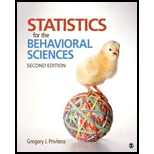
Concept explainers
(a)
Find the
(a)
Answer to Problem 12CAP
The range of data in the sample is 21.
Explanation of Solution
Calculation:
The data measures the number of minutes (per day) that a small hypothetical population of college students spends online. The sample consists of persons A, B, C, F, G, H, I, and J.
Range:
The difference between the largest value in the data set and smallest value in the data set is termed as range.
The formula for range is,
The largest value is 98 and the smallest value is 77. The range is,
Hence, the value of range is 21.
(b)
Find the IQR of data in this sample.
(b)
Answer to Problem 12CAP
The IQR of data in this sample is 11.
Explanation of Solution
Calculation:
Arrange the data in the numeric order 77, 82, 88, 88, 92, 94, 98, 98. That is
The formula to find the
Follow the below steps to calculate IQR for given data:
The position of
First quartile:
The median of the lower half of the values from
Compute position of
The position of first quartile for data is,
The value that is in position 2.5 is 82 and 88. The value of lower quartile
The lower quartile
Third quartile:
The median of the upper half of the values from
Compute position of
The position of upper quartile for data is,
The value that is in position o is 94 and 98. The value of upper quartile
The lower quartile
The interquartile range is,
Hence, the IQR of data in this sample is 11.
(c)
Find the SIQR of data in this sample.
(c)
Answer to Problem 12CAP
The SIQR of data in this sample is 5.5.
Explanation of Solution
Calculation:
The formula to find the semi-interquartile range is,
From part 2, the IQR value is 11.
The semi-interquartile range is,
Hence, the SIQR of data in this sample is 5.5.
(d)
Find the sample variance.
(d)
Answer to Problem 12CAP
The sample variance is 55.41.
Explanation of Solution
Calculation:
The formula for the sum of the squared deviation is,
The sample variance is,
Follow the below steps to find the sum of the squared deviation for given data.
The population meanis,
The squared deviation for score 98 is,
Similarly, the squared deviation for the remaining scores is obtained as shown in table (1).
| Minutes | Squared deviation |
| 98 | |
| 77 | |
| 88 | |
| 92 | |
| 94 | |
| 98 | |
| 88 | |
| 82 |
Table 1
The sum of squared deviation is,
The sample varianceis,
Hence, the sample varianceis 55.41.
(e)
Find the sample standard deviation.
(e)
Answer to Problem 12CAP
The sample standard deviationis 7.44.
Explanation of Solution
Calculation:
The samplevariance is 55.41.
The formula for the standard deviation is,
The standard deviation is,
Hence, the sample standard deviation is 7.44.
Want to see more full solutions like this?
Chapter 4 Solutions
Statistics for the Behavioral Sciences
 Glencoe Algebra 1, Student Edition, 9780079039897...AlgebraISBN:9780079039897Author:CarterPublisher:McGraw Hill
Glencoe Algebra 1, Student Edition, 9780079039897...AlgebraISBN:9780079039897Author:CarterPublisher:McGraw Hill
